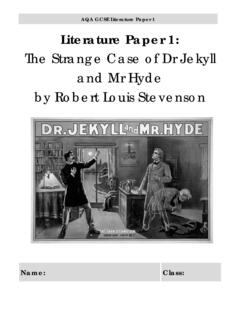Transcription of Elements of a Gothic novel in The Picture of Dorian Gray
1 Elements of a Gothic novel inThe Picture of Dorian GrayMathias J ungerFebruary 29, 2008 Contents1 Preface32 Definition of a Gothic The genre of the Gothic novel .. Typical motifs and characters .. Famous works .. 53 Influences on the The time of writing .. Literary influences .. 64 Elements of Gothic fiction appearing inThe Picture of Dorian The devil .. The atmosphere .. The bargain with the devil .. The secret room .. The supernatural .. The doppelg anger-motif.
2 The sudden break-out of violence .. Bad science .. Magical objects and the total dedication to things .. 95 Conclusion96 Bibliography107 Further reading108 Erkl arung1131 PrefaceIn this essay, I am first going to give a short and straighforward definition of the Gothicnovel, with a summary of it s history, it s themes and a few famous authors. My aim is toprovide an overview of the Gothic motifs appearing in Oscar Wilde sThe Picture of DorianGrayand an approach of interpretation for some of Definition of a Gothic The genre of the Gothic novelA new genre of fictional prose was introduced in the early 18th century.
3 It was knownas Gothic novel in England, as Schauerroman in Germany and as novel Noir inFrance. The term Gothic used to refer to the German tribe of the Goths, and lateronsignified Germanic , then medieval . It now identifies a style of Gothic novel , also known as Gothic romance , was initiated by Horace Warpol sCastle of Otranto, a Gothic Story(1764), and spread over the 19th ,haunted places such as castles, crypts, gloomy mansions and convents were a popular set-ting to embody the Gothic other important means to establish the typicaluncanny atmosphere was the use of supernatural Gothic genre emerged directly from changes in the cultural emphasis of the eigh-teenth century.
4 It stood for the contrast between the old-fashioned and the modern, thebarbaric opposed to the civilized and often for the English opposed to the European orFrenchified, which suited the Victorianic idea well. Gothic was always the archaic, thepagan, which refused to yield to the establishment of a civilized and well-regulated evolution of the Gothic genre came - by no means - suddenly; a famous and typicalpassage that shows the way poets predicted and anticipated the movement of the Gothicfiction can be found inNight-Piece on Deathby Thomas Parnell s (1833, first published1722):By the blue taper s trembling light,No more I waste the wakeful night,Intent with endless view to poreThe schoolmen and the sages o er:Their books from wisdom widely stray,1see Abrams, M.
5 H.,A Glossary of literary terms, 692see Drabble, Margret and Stringer, Jenny,Concise companion to English literature, 2683see Punter, David and Byron, Glennis,The Gothic , 7-84Or point at best the longest ll seek a readier path, and goWhere wisdom s surely taught below. (1-7)4 Parnell is saying something extremely radical for the times: He is not impressed by thelimits of the human species. According to his style of writing, it is required to take aquicker and more frightening way to find wisdom.
6 As he says, one can best, or possiblyeven only, explore the secrets of life by meditation on it s extremest limit: Typical motifs and charactersThe following motifs are common in the Gothic style and appear in almost every piece ofliterature belonging to the Gothic fiction: Uncanny environments such as castles, dungeons, prisons, cemeteries, .. The supernatural Monsters Doppelg angers Magic Objects Femme fatals Demons Walking skeletons The devil Witches and witchcraft Science used for a bad purposeAfter all, it is quite surprising, how many of these themes appear inThe Picture of DorianGray, even if implicitly or after Punter and Byron, 115see Punter and Byron, Famous worksA list of famous novels belonging to the Gothic genre, ordered chronologically.
7 Novelsmarking the begin of a new period and other particularities are shortly described. The Castle of Otranto- Horace Walpole, 1764. The work inaugurating the genre The Mysteries of Udolpho- Ann Radcliffe, 1794 The Monk- Matthew Gregory Lewis, 1796 The Italian- Ann Radcliffe, 1797 The Manuscript found in Saragossa- Jan Potocki, 1805 Frankenstein- Mary Shelley, 1818 Northanger Abbey- Jane Austen, 1818. This well-known novel was a parody makingfun of the vast interest of society in Gothic novels.
8 It marked the end of the genre sfirst phase6 Melmoth the Wanderer- Charles Maturin, 1820 The Mystery of Edwin Drood- Charles Dickens, 1870 The Strange case of Dr. Jekyll and Mr. Hyde- robert louis stevenson , 1886. Thisnovel introduced the Gothic revival Dracula- Bram Stoker, 1897 The Hound of the Baskervilles- Arthur Conan Doyle, 19023 Influences on the The time of writingAt the last decades of the Victorian period, when Oscar Wilde wroteThe Picture of DorianGray, the golden times of the Gothic Fiction had already passed.
9 It was rather a curiousrevival of the Gothic , which is often referred to as the Gothic revival , further famouspieces of literature of this era were R. L. Stephenson sThe Strange case of Dr Jekyll andMr Hyde(1886) and Bram Stoker sDracula(1897).76see Schellinger, PaulEncyclopedia of the novel volume 1, 4987see Drabble and Stringer, Literary influencesBefore writingDorian Gray, Wilde had already used the well-known motifs of Gothic fic-tion: His short-storyThe Canterville Ghostparodied the classical ghost , Oscar Wilde is said to have basedThe Picture of Dorian Grayon Maturin sMelmoth the Wanderer, one of the most famous examples of Gothic novels:Instead of making generalizations [.]
10 ] we may most usefully inquire into therelationship of Wilde s novel to it by looking closely at the Gothic noval thatwas most likely on his mind when he wroteDorian Gray. Charles R. Maturin[..] was an ancestor of Wilde; in fact, Wilde mentions his novelMelmoth theWandererand acknowledges the family relationship with some pride - Maturinwas his grand-uncle (Letters, p. 520).9 What Lewis Poteet writes in his article makes perfect sense. One could say, thatMelmoththe Wandererprovides patterns forDorian Gray: As an example, the protagonist ifMel-mothis able to survive 150 years without aging.






